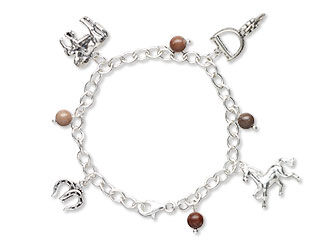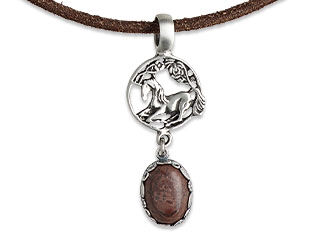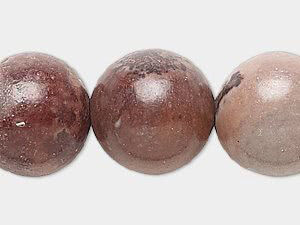Crazy Horse™ Stone (Calcite) Meaning and Properties
Crazy Horse Stone History
Crazy Horse™stone is the trade name for a calcite—a type of limestone material—showcasing a distinct appearance of brown, grey and tan with some mauve and pink color combinations. Calcites are a common mineral group, with high variability in color and form, and Crazy Horse stone is only one type.
What are the Metaphysical Properties of Crazy Horse Stone?
Calcites like Crazy Horse stone are said to aid memory and increase the strength of habits. Its worldwide distribution is considered to be a function of its universalism: it is believed to clear all chakras, raise overall body awareness and help connect people and energy beings into a united network.
Although not a birthstone, Crazy Horse stone meaning is affiliated with the Zodiac sign Cancer. It has no single associated chakra.
What is Crazy Horse Stone Made From?
One of calcite's most fascinating properties is that it emits electrical impulses when placed under pressure. Otherwise, this highly common mineral is considered rather ordinary. It is the most common mineral in stalactites (which hang from the ceilings of caves) and stalagmites (which form on the floors of caves).
Crazy Horse stone's blend of colors and patterns are due to the presence of aragonite and other trace minerals. Interestingly, calcite and aragonite are an odd set of almost-twin materials: they have the same chemical composition but differ significantly in crystal structure.
Calcites are found in limestones, marbles and chalk matrices. Major deposits of Crazy Horse stone are found in China.
- Mineral Information: Calcium carbonate with aragonite, iron, magnesium, manganese and other minerals
- Chemical Composition: CaCO3 and other minerals
- Color: Opaque brown, grey and tan with some mauve and pink
- Hardness: 3-1/2 to 4 (Mohs)
- Specific Gravity: 2.30 – 2.70
- Refractive Index: 1.49 – 1.66
How Do You Clean Crazy Horse Stone?
Like other calcites, Crazy Horse stone is highly sensitive to acids—even the mildest can cause damage to the surface of this extremely soft stone. It's often coated with a clear epoxy after cutting, to protect it from casual scratches, enhance luster and increase durability. (This coating does not affect the natural colors of the stone.)
Always remove jewelry made with Crazy Horse stone before doing activities where you might perspire, as human sweat can be surprisingly acidic. Avoid steamers, ultrasonic cleaners, polishing pastes and full immersions. Clean with a soft, damp cloth and pat dry.
Always remove jewelry made with Crazy Horse stone before perspiring, as human sweat can be surprisingly acidic. Avoid steamers, ultrasonic cleaners, polishing pastes and full immersions; clean with a soft, damp cloth and pat dry.
Crazy Horse Stone FAQ
Q: Where is Crazy Horse Stone mined or sourced from?
A: Major deposits of Crazy Horse stone can be found in China.
Q: How did Crazy Horse stone get its name?
A: Crazy Horse stone, with its hues of the American west, is named for the renowned Lakota Sioux war leader, Crazy Horse (Tȟašúŋke Witkó), who led his party to victory in the Battle of Little Big Horn in 1876.
Q: Is this stone suitable for everyday wear in jewelry?
A: With a Mohs hardness of 3-1/2 to 4, Crazy Horse stone can be easily damaged. Use it for jewelry pieces that get less wear, like necklaces, earrings and brooches.
Q: Is Crazy Horse stone an actual gemstone or is it a brand name?
A: Crazy Horse stone is a brand name for a variety of calcite with particular color patterns.
Q: What is the difference between Picasso jasper and Crazy Horse stone?
A: While Picasso “jasper” and Crazy Horse stone share a similar color palette, as well as links to the American west, they are very different stones. Crazy Horse stone is calcite, a relatively soft stone. Picasso “jasper” is not jasper at all, but limestone with a Mohs hardness of 6-1/2 to 7, making it durable enough for everyday wear. Picasso “jasper” tends to have streaks of color in tones of grey, white, dark brown, red and gold, whereas Crazy Horse stone has blotches of color rather than streaks, and a much softer color palatte that trends toward mauve and gray rather the gold and red of Picasso “jasper.”
Designing with Crazy Horse Stone
Crazy Horse stone is a very beautiful, graphic material which complements many other beads—designers only have to choose which of the colors in this stone to enhance! Pop pinks and mauves with rose quartz or pink shell; elevate greys with black onyx, black tourmaline or lava stone; or bolster a range of browns with camel jasper, petrified wood or natural wood beads.
As Crazy Horse stone is a fairly soft stone with an epoxy-enhanced surface, it's best used in designs that will not see a lot of impact. Best practices include earrings, ear cuffs, shorter necklaces and pendants. Avoid stringing next to extremely hard materials without bead caps or knots, to protect this stone from scratches, dents and other damage.
A Couple Design Ideas to Get Your Started
Shop for Crazy Horse Stone
**Please note that all metaphysical or healing properties listed are collected from various sources. This information is offered as a service and not meant to treat medical conditions. Fire Mountain Gems and Beads® does not guarantee the validity of any of these statements.
How did you like this resource? Your feedback helps us provide resources that matter to you most.
Copyright Permissions
All works of authorship (articles, videos, tutorials and other creative works) are from the Fire Mountain Gems and Beads® Collection, and permission to copy is granted for non-commercial educational purposes only. All other reproduction requires written permission. For more information, please email copyrightpermission@firemtn.com.




